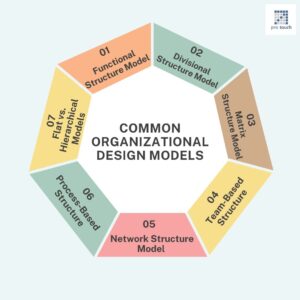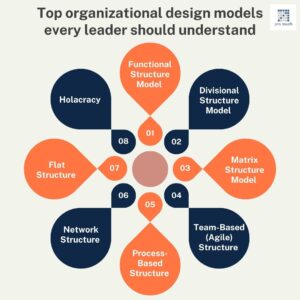Organizational design models are structured frameworks that help organizations align their structure, processes, and people with their strategy and goals. These models guide how roles, responsibilities, communication, and decision-making are organized within a company to achieve effectiveness and adaptability.
🔍 What is Organizational Design?
Organizational design is the process of shaping an organization’s structure to achieve its objectives and improve efficiency, collaboration, and innovation.
📊 Common Organizational Design Models:

- Functional Structure Model
- Structure: Organized by departments (e.g., HR, Marketing, Finance)
- Best for: Small to medium-sized companies or those with a single product/service
- Pros: Clear roles and specialization
- Cons: Limited cross-functional collaboration
- Divisional Structure Model
- Structure: Divided by product, service, geography, or customer type
- Best for: Large organizations with diverse products or markets
- Pros: Focused attention on specific markets/products
- Cons: Can lead to resource duplication
- Matrix Structure Model
- Structure: Employees report to both a functional manager and a project/product manager
- Best for: Project-driven or highly collaborative environments
- Pros: Encourages collaboration and flexibility
- Cons: Can cause confusion in authority and priorities
- Team-Based Structure Model
- Structure: Organized into cross-functional teams
- Best for: Agile or innovation-driven companies
- Pros: High adaptability, empowerment
- Cons: Requires strong team dynamics and communication
- Network Structure Model
- Structure: A central core that outsources major functions to other companies or units
- Best for: Companies focused on flexibility and partnerships
- Pros: Scalability, reduced overhead
- Cons: Less control over external partners
- Process-Based Structure
- Structure: Focuses on end-to-end workflows (like order-to-delivery)
- Best for: Companies focused on customer experience or operational efficiency
- Pros: Improves coordination across functions
- Cons: May require significant reengineering
- Flat vs. Hierarchical Models
- Flat: Few or no levels of middle management — more autonomy
- Hierarchical: Clear chain of command — more control
- Best for: Startups (flat), large corporations (hierarchical)
🧭 Choosing the Right Model
Selecting the right model depends on:
- Business goals and strategy
- Size and complexity of the organization
- Culture and leadership style
- Need for innovation vs. control
Here are the top organizational design models every leader should understand to effectively align people, processes, and strategy. These courses in change management, organizational development certification will help in understanding the models in detail.
✅ 1. Functional Structure Model
- Definition: Groups employees by specialized roles or departments (e.g., HR, Finance, Marketing).
- Best for: Small to mid-sized companies with a narrow product focus.
- Leaders Should Know: Promotes efficiency and expertise but can create silos.
- Example: Traditional corporate departments.
✅ 2. Divisional Structure Model
- Definition: Divides organization by product lines, geography, or customer segments.
- Best for: Large, diversified organizations.
- Leaders Should Know: Enables focus on specific markets but can duplicate functions.
- Example: Amazon (divisions for retail, AWS, Prime, etc.).
✅ 3. Matrix Structure Model
- Definition: Employees report to both functional and project/product managers.
- Best for: Organizations needing flexibility and collaboration.
- Leaders Should Know: Balances priorities but requires strong conflict-resolution skills.
- Example: Tech companies managing products across regions.
✅ 4. Team-Based (Agile) Structure
- Definition: Cross-functional teams work autonomously toward shared goals.
- Best for: Innovation-driven or agile organizations.
- Leaders Should Know: Increases speed and adaptability but requires strong team culture.
- Example: Spotify’s squad model.
✅ 5. Process-Based Structure
- Definition: Organizes around core business processes (e.g., order fulfillment).
- Best for: Operational excellence and customer experience.
- Leaders Should Know: Streamlines work, but requires rethinking traditional roles.
- Example: Logistics or manufacturing companies focused on lean operations.
✅ 6. Network Structure
- Definition: A central hub that connects to external partners, freelancers, or subsidiaries.
- Best for: Highly flexible, globally distributed teams.
- Leaders Should Know: Emphasizes partnerships and innovation but can lose control over quality.
- Example: Nike (outsources production, focuses on design and marketing).
✅ 7. Flat Structure
- Definition: Few or no layers of middle management.
- Best for: Startups or organizations that value speed and autonomy.
- Leaders Should Know: Fosters ownership, but can lead to role confusion.
- Example: Startups like Buffer or Valve.
✅ 8. Holacracy
- Definition: A decentralized model with no traditional managers; roles are fluid and self-governed.
- Best for: Experimental or forward-thinking companies.
- Leaders Should Know: Drives empowerment and innovation but needs high maturity and discipline.
- Example: Zappos.

🧭 Summary Table:
| Model | Best For | Leadership Focus |
| Functional | Specialization, efficiency | Coordination and communication |
| Divisional | Market or product focus | Autonomy and resource allocation |
| Matrix | Dual focus (function + project) | Managing complexity and clarity |
| Team-Based | Agility and collaboration | Team empowerment |
| Process-Based | Customer-centric, efficiency | End-to-end process ownership |
| Network | Innovation, scalability | Partner management |
| Flat | Speed, autonomy | Culture and clarity |
| Holacracy | Self-management | Role clarity and organizational maturity |
🧩 Conclusion:
Understanding organizational design models is essential for every leader aiming to build a resilient, efficient, and agile organization. Each model—whether functional, divisional, matrix, team-based, or networked—offers unique advantages depending on the company’s size, goals, and culture. Gain more knowledge with these courses in change management, organizational development certification.
By mastering these models, leaders can:
- Align structure with strategy
- Enhance collaboration and innovation
- Improve responsiveness to market changes
- Empower teams and streamline operations
Ultimately, the right organizational design enables better decision-making, stronger performance, and long-term growth. Leaders who stay flexible and intentional with structure will position their organizations for sustained success in a rapidly changing world.





Leave a Reply